The Gare du Nord: An Homage to Europe’s Train Busiest Station
- SUBSCRIBE
- ALREADY SUBSCRIBED?
BECOME A BONJOUR PARIS MEMBER
Gain full access to our collection of over 5,000 articles and bring the City of Light into your life. Just 60 USD per year.
Find out why you should become a member here.
Sign in
Fill in your credentials below.
Few visitors to Paris will be unaware of the Gare du Nord. If you’re arriving by Eurostar, this train station will be your first introduction to Paris. Located in the north of the city as its name implies, the Gare du Nord, situated in the 10th arrondissement, is not far from Montmartre but within easy commuting distance to the Left Bank.
In December 1967, I flew into Paris for the first time to be an au pair. Three weeks later, on Christmas Eve, I left Paris via the Gare du Nord and the boat train to London Victoria and thence on to my home in the north of England. The au pair job had been a disaster, but I had found another and was crossing everything that this one would work after the family returned from their Christmas break in Périgueux. I can’t say that the Gare du Nord had left much of an impact on me. Victorian stations were almost all universally beautiful; Newcastle Central Station, with its domed glass roof and wrought-iron walkways, was no exception.
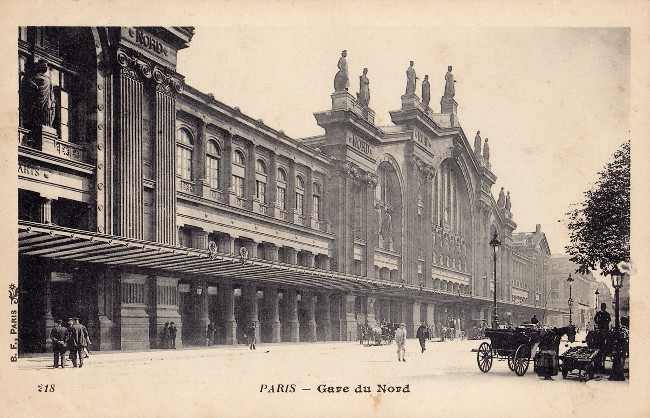
The famous facade of Gare du Nord around 1900. Public domain
Returning to Paris was a different story. I stood on the platform and breathed in that inimitable smell of a Parisian train station. Cigarette smoke, coffee, diesel and something else which was indefinable, but somehow the essence of Paris… It brought tears to my eyes. I was home again. The Gare du Nord was to affect me in the same way each and every time over the next year and a half. I was either leaving Paris, or returning, and the Gare du Nord was always my first and last witness. The Gare du Nord has been smoke-free since 2007, but in the intervening years from 1846, I imagine it would have smelt pretty much the same as when I first stood on its platform.
First officially opened in 1846 for the Chemins de Fer du Nord, the station has a fascinating and checkered history which continues to this day. Controversy was never far away from its tracks.
As with so many of these new railway stations in an age of unimagined innovation, the popularity of train travel was instant and soon resulted in the stations becoming too small for demand, the tracks insufficient in number to cope for the large numbers of passengers who had embraced trains and all they had to offer with unabated enthusiasm.
Less than 20 years later, in 1860, the station was partly demolished to enable a larger station to be built. With great foresight, and an instinct for heritage sadly lacking sometimes in later years, the facade of the station was transferred to Lille station where it still remains to this day.

Postcard depicting a train departing from the Gare du Nord before the First World War. Public domain
The cast iron to support the U-shaped structure was produced in Glasgow which was the only foundry large enough at the time to produce the supports. The stone facade, a triumphal arch, was graced by nine statues, the center statue representing Paris and the other eight representing the different urban destinations accessed by the train company: London, Amsterdam, Berlin, Brussels, Cologne, Frankfurt, Vienna and Warsaw.
The original station was designed by Léonce Reynaud, but the new Beaux-Arts, neoclassical style of architecture was the work of a German-born French architect, Jacques Ignace Hittorff.
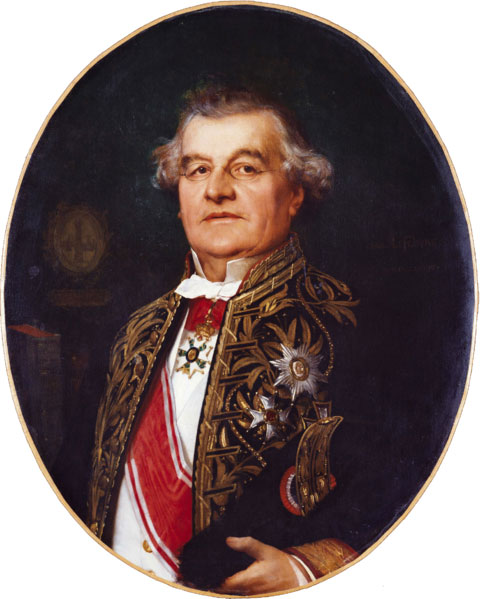
Portrait of Léonce Reynaud, 1870, Public Domain
As with stations in so many cities, the area around the Gare du Nord, both then and now, has always been unsatisfactory: too crowded, often unsafe, a nightmare for traffic. Ironically, the blame for this has been laid at the door of Georges-Eugène Haussmann, the baron responsible for the city’s metamorphosis in the 19th century. The original plans included a monumental avenue leading up to the station’s entrance cutting a swathe through the old, narrow streets, something that Haussmann, in his massive redevelopment of Paris, had done without a qualm. But Haussmann took the design of the area around the Gare du Nord personally. He was unhappy with the huge expense that the city would have to bear and for the next 20 years from 1838, some dozen separate proposals were ignored and eventually fell by the wayside. The station suffered the consequences of poor access and lack of space. In 1884 an additional five tracks were added in anticipation of the 1889 World Fair and its controversial showcase, the Eiffel Tower.

Baron Georges-Eugène Haussmann (1809-1891), Prefect of Paris, urbanist of the Napoleon III’s Paris, Public Domain
There was more expansion work in the 1930s and the 1960s and in 1994, the hugely successful inauguration of the high speed Eurostar International, required more reorganizing of the rail tracks. But for a station that was to become the busiest in Europe — seeing 700,000 passengers a day in 2015— it was apparent that a major expansion would be required.
The Gare du Nord was fortunate to escape the ravishes of modernism in the 1960s. The Gare d’Orsay, now the splendid Musée d’Orsay, was earmarked for destruction and just saved at the last moment from being replaced by a modern hotel. Likewise, London’s St. Pancras station, home to the international Eurostar services to the Gare du Nord, nearly suffered the same fate. The stunningly ornate Victorian-Gothic building was falling slowly into disrepair by the 1960s. Bomb damaged and neglected, covered in layers of London soot, its former grand hotel long since closed, and its rail lines massively underused.

Paris: Pont Royal and the Gare d’orsay – drawing by Paul Signac, Public Domain
Its unlikely savior was a poet. Sir John Betjeman, poet Laureat, an unceasing advocate for Victorian architecture, began a campaign to save his beloved St. Pancras. Just 10 days before the wrecking balls were due, the station was given Grade 1 listing. It may have been safe from demolition but it was only the decision to make it the new International Eurostar terminus in 2007, combined with a £800 million pound refurbishment, that turned its fortunes around and the building back to its former glory. The renovation was so stunning— it even boasts the longest Champagne bar in Europe— that it was inevitable that the Gare du Nord would suffer by comparison. Although a new departure terminal was opened to accommodate the high-speed rail services, and not accounting for the problems of space outside the Gare du Nord, the interior of the Gare du Nord simply didn’t work. Retail units obstructed the main concourse, and with the Gare du Nord’s huge daily footfall, passengers were often reduced to sitting on the floor. It has to be remembered that the Gare du Nord does not only serve international destinations, but also national and local stations throughout the north of France via RER lines, and its footfall is around five times that of St Pancras. (Some 300 million passengers use the Gare du Nord annually, only 3% attributable to Eurostar travelers.)
Expansion was as an inevitable as the vociferous controversy that surrounded the project.
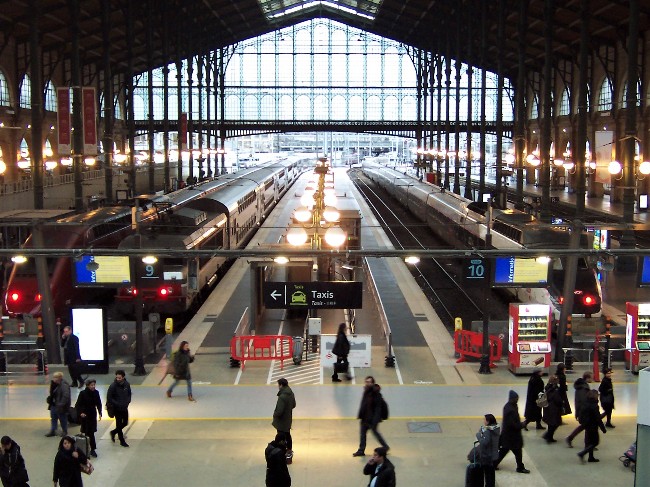
Paris Gare du Nord. Photo credit: TeaMeister / Wikimedia commons
In 2015, architect Jean-Michel Wilmotte was employed by the SNCF to “open the the station towards the city.” The SNCF, alongside private investors including the giant supermarket chain Auchan, had joined forces and finances to transform the Gare du Nord into a massive shopping and office complex, more resembling an airport than a rail station. The estimated cost? Some 600 million euros. The finished station was to enlarge its footprint by almost two and a half times, building upwards and out with some 50,000 square meters of floor space housing shops, restaurants, gym, putting range, tennis court and a fitness trail. Fifty five lifts and 105 escalators would double the pre-development number. The completion date of late 2023 was to coincide with the Olympic games hosted by Paris in 2024.
Local residents groups objected fiercely to the proposals, eminent architects including Jean Nouvel, alongside urban planners, joined forces labeling the plans “indecent” and “a serious urban mistake.” The inclusion of this massive retail outlet on the roof of the Gare du Nord and only one stop away from the Forum des Halles at Châtelet invoked fury by residents living around the station at the prospect of dozens of delivery lorries and rubbish trucks choking up the already congested streets. Small cafes and retail shops around the Gare du Nord, relying on travelers for their business, would find that competing with a giant outlet would only add to their woes.
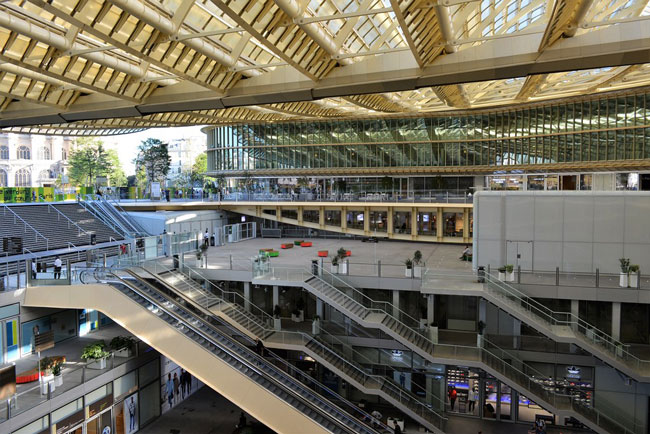
Forum des Halles at Châtelet, Carl Campbell at Creative Commons
The 10th arrondissement is the most densely populated in Paris. Some 100,000 inhabitants live in less than three square kilometers – their numbers swelling by almost a million as passengers arrive daily. A thermal image of the area around the Gare du Nord showed it was the hottest part of Paris, possessing no trees or parks to help dissipate the heat or reduce the carbon count.
Mayor of Paris Anne Hidalgo was opposed to the massive redevelopment plan which she maintained would enable big firms to make money and was more about the shopping complex than the railway. She advocated a much smaller, state-financed refit. President Macron’s junior transport minister, Jean-Baptiste Djebbari, disagreed stating that the project was necessary for “the hundreds of thousands of locals and tourists who use the station daily.” Ultimately, the City of Paris, which was not in charge of the project, could only object from the sidelines and it seemed that the development was destined to go ahead regardless of all the objections. The plans were approved in July 2020 and it seemed all hope for the protesters were lost.
And then in September 2021, finance reared its ugly but welcome head. The property developer Ceetrus, the real estate subsidiary of Auchan supermarket, announced that not only was it anticipating additional costs, bringing the project’s total cost to 1.5 billion euros, tripling the original estimate of 500 million euros, but also that the project would not now be completed until 2026 thereby missing the opening of the Paris Olympic Games in 2024.
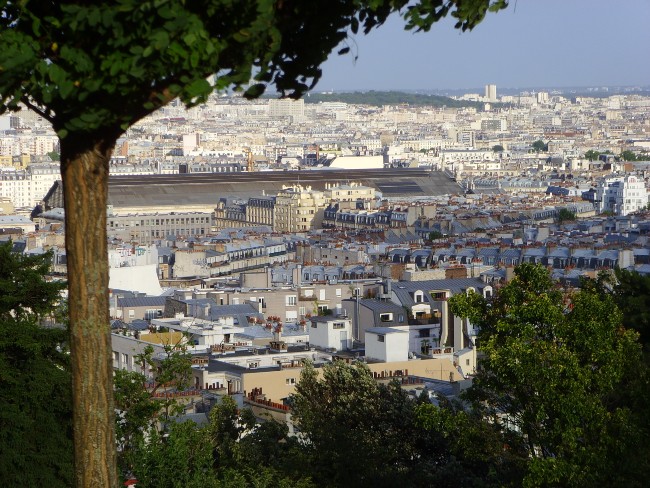
The vast hall of the Gare du Nord as seen from Montmartre. Photo credit: Luctor / Wikimedia commons
The project was canceled. The SNCF Gares & Connexions pledged immediately a 50 million euro adaptation of the Gare du Nord, Plan B, to meet the challengers of the Rugby World Cup in 2023 and more importantly, the Paris Olympics the following year. Plans afoot are to add escalators, redevelop the bus station, add parking spaces for bicycles (a much vaunted request), review the taxi areas and improve the waiting room and boarding areas for Eurostar.
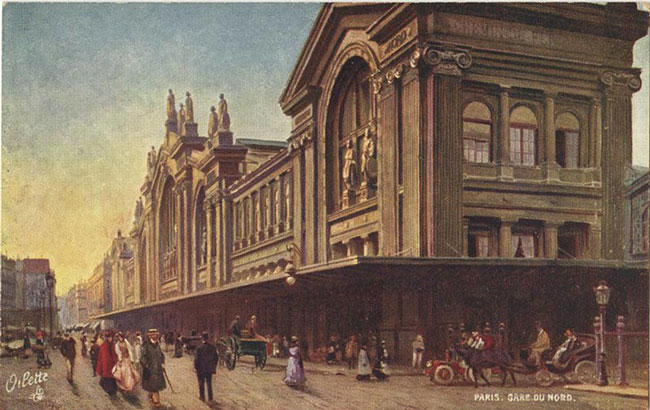
Series ” Villes De France, Paris VIII ” 952. Oilette postcard view of Paris Gare Du Nord Station, 1917, Public Domain
The chairman of Ceetrus, Antoine Grolin, was quoted as saying that he didn’t know what they were going to do with just 50 million, “apart from changing the windows and putting on a new coat of paint.” I guess we’ll just have to wait and see?
On a lighter note, the Gare du Nord has featured in numerous French and English movies. In The Pursuit of Love, the heroine, Linda, meets Fabrice as she sits weeping on her suitcase. (Sadly I wasn’t offered the part.) In 2002, The Bourne Identity and The Bourne Ultimatum, 2007, featuring Matt Damon, had scenes shot in the Gare du Nord. Ocean’s 12, Mr Bean’s Holiday, and scenes of Gossip Girl were also shot there.
From their inception, railway stations have continued to evoke a special, sometimes intangible, nostalgia, and whatever its future may hold, the Gare du Nord will remain at the heart of Parisian life and the beginning and end of a very special experience for travelers worldwide.
Lead photo credit : The monumental facade of the Gare du Nord. Photo credit: Velvet / Wikimedia commons
More in Gare du Nord, History of Gare du Nord, Paris Gare Du Nord, Paris Railway Station, SNCF
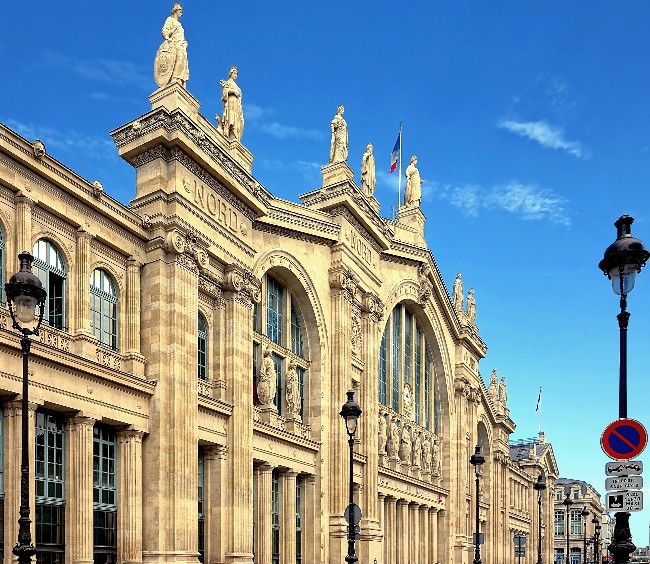
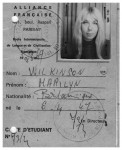
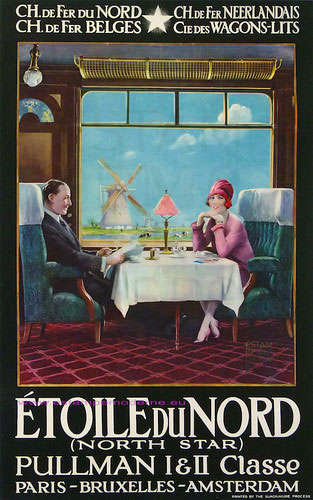






REPLY
REPLY